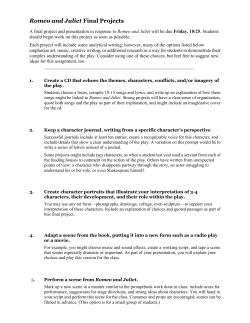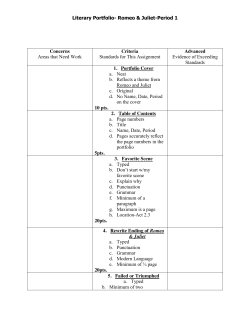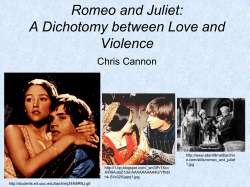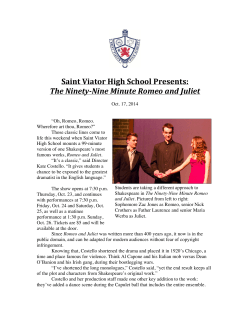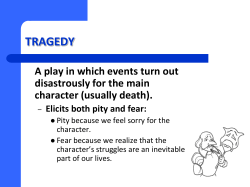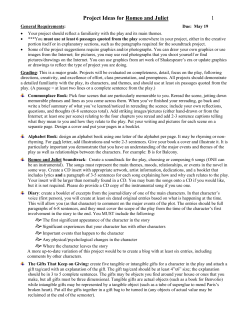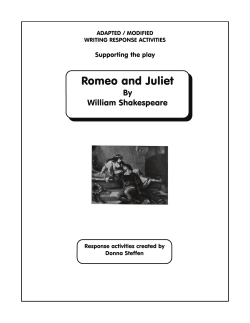
Unit 4: Conflict and Conflict Resolution
Unit 4: Conflict and Conflict Resolution Ms. Settles English 9/Humanities 2015 Name: ___________________________ Important Unit Information Standards: ➔ RL 1/RI 1: Read closely to determine what the text says explicitly and to make logical inferences from it; cite specific textual evidence when writing or speaking to support conclusions drawn from the text. ➔ RL 7: Integrate and evaluate content presented in diverse formats and media, including visually and quantitatively, as well as in words. ➔ W 1: Write arguments to support claims in an analysis of substantive topics or texts, using valid reasoning and relevant and sufficient evidence. ➔ W 10: Write routinely over extended time frames (time for research, reflection, and revision) and shorter time frames for a range of tasks, purposes and audiences. ➔ SL 1: Prepare for and participate effectively in a range of conversations and collaborations with diverse partners, building on others’ ideas and expressing their own clearly and persuasively. ➔ SL 3: Evaluate a speaker’s point of view, reasoning, use of evidence and rhetoric, identifying any fallacious meaning or exaggerated or distorted evidence. ➔ L 6: Acquire and use accurately a range of academic and domainspecific words and phrases sufficient for reading, writing, speaking and listening at the college and career readiness level; demonstrate independence in gathering vocabulary knowledge, when considering a word or phrase important to comprehension or expression. Table of Contents/Activities: 1. Reading Literature and Informational Texts a. Reading Formats b. Reading Strategies 2. Do Now Activities a. Vocabulary b. Journal Prompts c. Educational Games 3. Poster Gallery Walk 4. Anticipation Guide 5. Prologue Translation Activity 6. Contextual Vocabulary List 7. Literary Discussions & Strategies 8. “Who is to Blame for the Death of Romeo and Juliet?” Debate 9. AT Honors Assignment & Meeting 10. Short Comparative Analysis Writing Piece & Viewing of 2 Movie Versions 11. Rewriting Romeo and Juliet as a World Conflict Formative and Summative Assessments: ★ Reading Strategies for In Class Reading & Independent Flipped Lessons ★ Contextual Vocabulary.com Assessment ★ Literary Discussion Notes & Reflections ★ Who is to Blame for the Death of Romeo and Juliet? Debate ★ Honors Assignment: West Side Story Discussion ★ Short Comparative Analysis Writing Piece ★ Rewriting Romeo and Juliet as a World Conflict Reading Literature & Informational Texts We will read Romeo and Juliet in the following formats: ○ Whole Class Reading ○ Group Reading ○ Honors Reading/Viewing of West Side Story ★ Students will use various reading strategies with unit readings in/outside of class: ○ Journals Notes/DTQs ○ Class Forum Posts ○ SOAPSTone ○ SIFT Analysis ○ Flipped Lesson Notes Sheets ★ Students will complete independent “flipped” lessons on their own time including: ○ Recorded Articles on Adolescence ○ Videos/TED Talks ○ Shakespeare’s Background Information/Historical Context/Contribution to English Language ○ Persuasive Techniques for Debate & Argumentation ○ And more... TBA! ***What is the Flipped Classroom? The Flipped Classroom is a new way to look at the way schools work. For this unit, our class will be experimenting with the “Flipped Classroom” model. The class lessons will take place outside of class time on student’s own time. Students may also rewatch flipped lessons if they did not master the content the first time. Class time will be based on the workshop model and students will watch instructional videos outside of class in place of typical reading and writing homework. ★ __________________________________________________________________________ Do Now Activities ★ Throughout the unit, students will participate in the following Do Now activities: ○ Vocabulary ■ Quick Poster Presentations ■ Vocab Journal ■ Contextual Vocabulary.com Assessment ○ Journal Prompts ■ Conflict/Conflict Resolution ■ Character Analysis ■ Somebody Wanted But So ■ Article Responses ○ Educational Games ■ Headbands ■ Shakespearean Insults ■ Vocabulary Game ■ Silly Scene Reenactment ______________________________________________________________________ Poster Gallery Walk ★ Participate in the Poster Gallery Walk as a class. Visit each poster and write your prior knowledge about each of the topics on the posters.. At the end of the Gallery Walk, we will go over the information as a class to assess what we know right now about Shakespeare and his works. Anticipation Guide Directions: Fill out the following guide with A for Agree, D for Disagree or IDK for I don’t know. You also need to write one sentence of explanation for each statement. Be ready to share your answers for participation points. ______1. It is okay to go against your family, religion or cultural standards when you are dating. ______2. It is okay to go against your family, religion or cultural standards when you are getting married. ______3. It is okay to be in a relationship with someone who lies to his/her friends or family about your relationship. ______4. “Love at first sight” is rare, but it does happen. ______5. Love conquers all (if you love someone, nothing else matters). ______6. It is okay to lie to protect other people and/or to avoid conflict. ______7. Personality is more important than looks in finding a boyfriend/girlfriend. ______8. Arranged marriages are a good idea. ______9. It is possible to die of grief or a broken heart. ______10. It is better to take love slowly than to rush into things and act on impulse. ______11. Parents always make the best decisions for their children. ______12. It is okay to hate someone just because your family does. ______13. Romeo and Juliet is a love story. Prologue Translation Activity 1) Read the prologue once as a class. Number each line. 2) Answer the question after discussing it as a class. What did you get out of it? What do you think is happening in the prologue? 3) Rhyme scheme the poem. To do this, you look at the last word of every line. Label the first line A, each last word that creates a new rhyme gets a new letter. If two words on different lines rhyme, they get the same letter. What type of poem is this? 4) With a small group, try to rewrite each line of the prologue in your own words. Write your group’s version below. Be ready to share out. Look up any words you do not know. Contextual Vocabulary List 1. 2. 3. 4. 5. 6. 7. 8. 9. 10. 11. 12. 13. 14. 15. 16. 17. 18. 19. 20. 21. 22. 23. 24. 25. 26. Tragedy = a play dealing with tragic events and having an unhappy ending, esp. one concerning the downfall of the main character. Tragic Flaw = a fault in the protagonist that leads to the downfall or death of that character. Irony = a figure of speech which is a contradiction between what is expected and what actually occurs. Dramatic Irony = when the audience knows something the characters do not know Verbal Irony = the use of words to mean something different than what the character is intending to say. Situational Iron y= when the exact opposite of what is meant to happen, happens. Aside = when a character speaks only to the audience or to just one of the other characters. Soliloquy = when a character speaks to himself or herself about their feelings or emotions. Monologue = long speech by one character to other characters or audience, thinking aloud Dialogue = conversation between two or more characters. Foil = a character used to contrast another character to highlight particular qualities of the other character. Comic Relief = some sort of humor added in to lessen the seriousness of the play. Pun = a form of word play that suggests two or more meanings words that are usually humorous. Couplet = two consecutive rhyming lines of poetry. Blank Verse = poetry verse without rhyme written in iambic pentameter. Iambic Pentameter = a type of meter Shakespeare wrote in when he wrote verse consisting of 5 unstressed and 5 stressed syllables. Allusion = a reference in one work of literature to a person, place, or event in another work of literature or in history, art, or music. Analogy = an extended comparison showing the similarities between two things. Characterization= the personality a character displays; also, the means by which the author reveals that personality. Diction = a writer’s choice of words for clarity, effectiveness, and precision. Dramatic Structure = the structure of a play. Protagonist = the main character in a play or story. Antagonist = the character or force that works against the protagonist; introduces the conflict. Simile/Metaphor = Simile a comparison made between two unlike things through the use of a specific word of comparison such as like and as. Metaphor comparison between two unlike things with the intent of giving added meaning to one of them. Sonnet = a fourteenline lyric poem, usually written in iambic pentameter, that has one of several rhyme schemes the most common being abab cdcd efef gg. A sonnet form used by William Shakespeare is called the Shakespearean sonnet. Rhyme Scheme = the ordered pattern of rhymes at the ends of the lines of a poem or verse. Literary Discussions & Strategies Literature Circles Explanation: We will also complete our first literature circles for this unit. Students will take on 3 of the roles as listed below. Groups will then have a discussion about student findings. 1. Super Summarizer Writes a short summary of what happened in the text including the most important points. 2. Idea Inferencer Make inferences and predictions about the text and find quotes to back up your guesses. 3. Central Idea/Claim Creator Figure out a central idea/theme or claim of the text and find a quote to back up your theme or claim. 4. Character Creeper Tells about the characters, settings or plot of the text, what they are like and how they develop and interact with other characters. 5. Word Wizard Finds diction, dialect and vocabulary and tells why they are important to the story. 6. Comparison/Connection Crafter Come up with ways to connect and compare this text to other texts, movies, shows, or sources. 7. Text Structure Spotter Find the different text structures of the text and discuss the significance of these and how they impact the whole text. 8. Point of View/Purpose Prophet Figure out the POV or purpose of the text and find evidence to back it up. Literature Circles Notes Sheet Act/Scene: ____________ Directions: Take notes based on the three roles you chose with your group for literature circles. You should have at least 5 sentences or bullet points for each role. Evidence from the text is required for all of these roles. Make sure to write down your pages numbers. Use this sheet in the literature circle discussions. Role #1: Role #2: Role #3: Mini Socratic Group Discussions Explanation: After finishing certain scenes, students will participate in mini socratic group discussions. Students will use teacher and student made DTQs (Deeper Thinking Questions) to have a discussion. Students will have a discussion and share out their thoughts on each question. All students will be involved in the discussions. After students are done discussing each question, they will fill out a folded notes sheet with each group member’s DTQ and notes from the discussions. Follow the following process: 1) Find at least 1 DTQ to ask during the discussion. DTQs may be student made or given by the teacher. 2) One student will start by asking a DTQ. 3) All students will share out answers, thoughts and opinions on the question. 4) Whole group takes notes on DTQ Diamond Notes Sheet. 5) Repeat until all students have completed the process. DTQ Folded Notes Directions: 1. Fold a sheet of paper in half and then in half again. 2. Draw lines to divide the paper into four quadrants. 3. Write one group member name at the top of each quadrant. 4. After discussing each DTQ, students will write down the respective group member’s DTQ and notes from the discussion in each box. Who is the blame for the death of Romeo and Juliet? Debate Explanation: Students will prepare for and participate for a group debate on the topic “Who is to blame for the death of Romeo and Juliet?” Students will be put into groups and will be given one of the following character(s) and will prepare an argument to blame one of the following characters for the couple’s deaths. ★ Friar Lawrence ★ Romeo and Juliet ★ Montague and Capulet Families ★ The Nurse ★ Tybalt, Benvolio or Mercutio Before beginning this project, students will view an independent flipped lesson about persuasive techniques and argumentation. Students will use their reading strategy notes to help with writing their group’s debate script. Student groups will practice their debate and then will participate in an actual debate discussion format in front of guest judges! Judges will evaluate each team’s argument. _____________________________________________________________________________________ Key Terms/Ideas for Argumentation & Persuasive Techniques Aristotle (384 BC) Aristotle was a Greek philosopher and scientist who was known as a master of many areas of knowledge. He divided the means of persuasion into three categories listed below: Ethos, Pathos and Logos. ● ● ● ● ● ● ● ● ● ● ● ● ● Audience those who will hear an argument; more generally, those to whom a communication is addressed. Argument A set of reasons given with the aim of persuading an audience. Claim Your basic belief about a particular topic, issue, event, or idea Reasons The explanation for the claim. Evidence/Support Quotes, facts, statistics used to support your point. Counterclaim A solid and reasonable argument that opposes or disagrees with your claim Rebuttal A written or verbal response to a counterclaim. The object of the rebuttal is to take into account the ideas presented in the counterclaim and explain why they aren’t persuasive enough, valid enough, or important enough to outweigh your own claim. Fight back against the counterclaim! Refute Argue against a position or prove it to be wrong Qualify A “partlyagree” stance in which you agree (in part) with another person’s argument or position but also disagree with part of it. Fallacy a mistaken belief, especially one based on unsound argument. Ethos the qualities of character, intelligence, and goodwill in an argument that contribute to an audience's acceptance of the claim. Pathos a quality that evokes pity or sadness. Logos persuasion by the use of reasoning. 1st Stage: Planning the Debate Directions: In groups, students will be given one of the above characters to blame for the death of Romeo and Juliet. Next, groups will fill out the following planning sheet and come up with evidence for their argument. Groups must have at least 3 reasons with 3 pieces of evidence (quotes) to support their argument. Groups are also expected to explain their evidence with details. Groups will also provide a counterclaim with evidence and a concluding statement. The goal is to be the most persuasive and to win the debate. Complete the following planning sheet with your group and determine who will be speaking for each part of the debate. Each group member is required to speak during the debate. Planning Sheet: 1. Opening Statement (Your Argument): We are arguing that the one responsible for the death of Romeo and Juliet is ______________ because of the following 3 reasons. These reasons include… (Person Speaking: ) 2. Reason #1: The first reason why _____________ is to blame for the death of Romeo and Juliet is because… (Person Speaking: ) 3. Evidence #1: The evidence that supports this is… (Person Speaking: ) 4. Explanation #1: This evidence means that… (Person Speaking: ) 5. Reason #2: The second reason why _____________ is to blame for the death of Romeo and Juliet is because… (Person Speaking: ) 6. Evidence #2: The evidence that supports this is… (Person Speaking: ) 7. Explanation #2: This evidence means that… (Person Speaking: ) 8. Reason #3: The third reason why_____________ is to blame for the death of Romeo and Juliet is because… (Person Speaking: ) 9. Evidence #3: The evidence that supports this is… (Person Speaking: ) 10. Explanation #3: This evidence means that… (Person Speaking: ) 11. Counterclaim: Some may say that ____________ is to blame for the death of Romeo and Juliet because … but the truth is that ___________________is to blame for the death of Romeo and Juliet because… (Evidence Quote) (Person Speaking: ) 11. Concluding Statement: (Person Speaking: ) 2nd Stage: Implementing Debate Everyone will come together for the second part of the debate. We will follow this format for our whole class debate. Judges will evaluate how well the group argues their case. Debate Order: Group 1 Opening Statement Group 2 Opening Statement Group 3 Opening Statement *Group 4 Opening Statement *Group 5 Opening Statement Group 1: 1st Reason/Evidence/Explanation Group 2: 1st Reason/Evidence/Explanation Group 3: 1st Reason/Evidence/Explanation *Group 4: 1st Reason/Evidence/Explanation *Group 5: 1st Reason/Evidence/Explanation Group 1: 2nd Reason/Evidence/Explanation Group 2: 2nd Reason/Evidence/Explanation Group 3: 2nd Reason/Evidence/Explanation *Group 4: 2nd Reason/Evidence/Explanation *Group 5: 2nd Reason/Evidence/Explanation Group 1: 3rd Reason/Evidence/Explanation Group 2: 3rd Reason/Evidence/Explanation Group 3: 3rd Reason/Evidence/Explanation *Group 4: 3rd Reason/Evidence/Explanation *Group 5: 3rd Reason/Evidence/Explanation Group 1: Counterclaim Group 2: Counterclaim Group 3: Counterclaim *Group 4: Counterclaim *Group 5: Counterclaim Group 1: Concluding Statement Group 2: Concluding Statement Group 3: Concluding Statement *Group 4: Concluding Statement *Group 5: Concluding Statement After the debate, chosen judges will evaluate the groups using the attached rubric. One group will be chosen as the winner of the debate. All groups will get a prize and the winning group will get bragging rights! Debate Rubric Group Name: _______________ Criteria 4 A 3 B 2 C 1 D/F Opening Statement Opening statement gives a clear definition of the argument and introduces the argument effectively for the audience. Opening statement gives an adequate introduction to the argument. Opening statement may be lacking in its introduction to the argument. Opening statement is weak and does not introduce the argument effectively. Reason 1/ Evidence/ Explanation Reason 1 makes a clear claim about the argument, provides effective evidence and explains the evidence thoroughly. Reason 1 makes a claim, provides evidence and explains the evidence effectively. Reason 1 makes a claim, provides evidence and explains the evidence but may be lacking in clarity or effectiveness. Reason 1 is lacking in either a claim, evidence or explanation. One of these aspects may be missing altogether. Reason 2/ Evidence/ Explanation Reason 2 makes a clear claim about the argument, provides effective evidence and explains the evidence thoroughly. Reason 2 makes a claim, provides evidence and explains the evidence effectively. Reason 2 makes a claim, provides evidence and explains the evidence but may be lacking in clarity or effectiveness. Reason 2 is lacking in either a claim, evidence or explanation. One of these aspects may be missing altogether. Reason 3/ Evidence/ Explanation Reason 3 makes a clear claim about the argument, provides effective evidence and explains the evidence thoroughly. Reason 3 makes a claim, provides evidence and explains the evidence effectively. Reason 3 makes a claim, provides evidence and explains the evidence but may be lacking in clarity or effectiveness. Reason 3 is lacking in either a claim, evidence or explanation. One of these aspects may be missing altogether. Counterclaim Counterclaim is done very effectively, includes all parts and tactfully refutes the other group’s argument. Counterclaim is given and refutes the other group’s argument successfully. Counterclaim is given but may be lacking in some aspects. Counterclaim is lacking in evidence and did not refute the other group’s argument effectively. Concluding Statement Concluding statement effectively sums up the argument. Concluding statement provides a sufficient ending to the argument. Concluding statement provides an ending to the argument. Concluding statement may be lacking in some respects. Team Score: _______________ AT Honors Assignment and Meeting Explanation: Honors students have a choice in their honors assignment for this unit. Students may either read the book West Side Story (borrow a copy from Ms. Settles) or they may watch the movie and read an article on the play. Write at least 3 DTQs about the book or movie/articles and be ready to participate in a discussion during AT. __________________________________________________________________________ Short Comparison Writing Piece Explanation: As a class, we will be watching the modernized movie version of Romeo and Juliet starring Leonardo DiCaprio and Claire Danes. We will also watch scenes from an older, more original version of the play. Honors students will either read West Side Story or will watch the movie and read an article. Students will write a short writing piece comparing the play to each of the movies. Students will fill out a venn diagram before writing. Students will be given a length of time to write this comparison piece in class. Focus on content over length of writing. Please use evidence from the text whenever possible. In all, you should use at least 2 cited quotes in your response. Students will answer the following prompt: How did the movies and the play relate to one another? What was similar between the movies and the plays? What was different between the movies and the play? Were there any aspects of the movies that were better than the play or vise versa? What was memorable about the play or movies? Is there anything that you would have imagined differently than it was shown in the movies? Which version did you like best? CP Venn Diagram: Honors Venn Diagram: Re-Inventing Romeo and Juliet as a World Conflict Directions: In History, students will be researching various world conflicts. In English, students use their research to rewrite a part of Romeo and Juliet in the context of one of the following world conflicts. Then, students will come together and plan out their skit, come up with ideas for costumes, scenes, props and more. Students will perform their skits and will be responsible for presenting their research to their classes. World Conflicts: ● Israel and Palestine ● Ireland and Northern Ireland ● Serbia and Bosnia ● Hutu and Tutsi (Rwanda) ● North Korea and South Korea ● Sunni and Shiite (Iraq) ● Ukraine and Russia ● USA and Iraq Process: 1) You will be put into groups in English. 2) Your groups will choose one of the conflicts to research. 3) You will independently research the conflict and write a research paper in History class. 4) Using research from History class, with your group, you will rewrite an assigned scene from the play in the context of your world conflict. 5) Present your research and scene. Requirements for Rewritten Scene (English): ❏ A script of an assigned scene rewritten in the context of a world conflict. Your script should have all characters and events represented. Don’t skip any details! ❏ You will be responsible for acting out the skit and all students in each group are required to be involved in the skit in some way as a character or narrator ❏ Character names should be culturally appropriate. ❏ At least 3 representations of costumes for different characters (drawings, digital images or real costumes). ❏ Using props will be expected. ❏ At least 1 representation of setting (drawings, blueprints, digital image/model) ❏ At least 1 piece of music/a song for each country involved in the conflict that connects to the mood of the scene. ❏ Rehearse your scene before performing the skit! Rubric to follow!
© Copyright 2025
